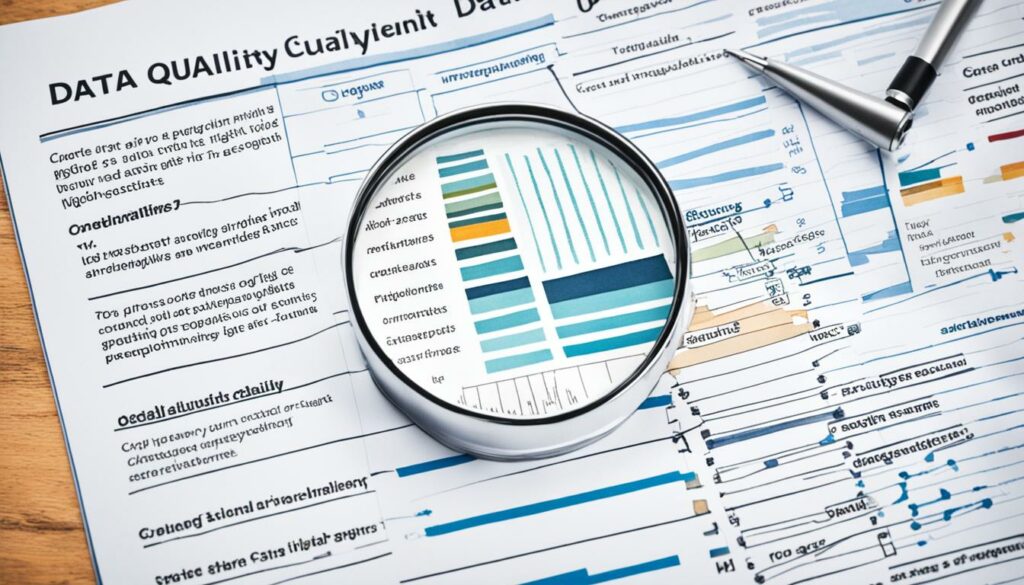Menu

Did you know that 49% of companies think market analytics are key to making smart plans? Deloitte’s study shows this, pointing out the big role insights play in modern business plans. Only 3% of data sets check out as good, according to Harvard Business Review. This shows we really need to up our data game. While 31% say their data use is fine, a huge 35% keep fighting with data that doesn’t work together. This is a big challenge for companies who want to dive deep into market trends and use the latest data skills.
To go beyond usual number crunching, companies need to use advanced tools. Things like natural language processing (NLP), artificial intelligence (AI), and machine learning are key. By making sure everyone knows how to handle data, setting clear data rules, and keeping all data in one place, they can do much better. This way, they can get important info faster, make smarter choices based on data, and get ahead in their business field.
In today’s world, understanding the market is crucial. It helps find key insights and guide important decisions. To succeed, companies must look closely at large amounts of data. They then turn this data into actions that improve their strategies.
Market data analytics uses various methods to understand data. This includes looking at past trends and customer behaviour (descriptive analytics). It also involves finding patterns to explain performance (diagnostic analytics).Another important part is predictive analytics. This tries to predict what might happen in the future. And there’s prescriptive analytics, which suggests what to do based on the predictions. Common tools for these analyses are Excel, SQL, and Python.
Making data part of a business’s daily routine is key. By using data in all areas, companies can stand out. Data itself doesn’t do much until we analyse it. Then, it becomes a strong guide for decisions.Building a solid statistical analysis base helps companies face market challenges. It gives them clarity and the ability to plan ahead.
Ensuring the quality of data is key for useful insights. Poor data quality has serious effects. IBM says it cost the U.S. $3.1 trillion in 2016. Bad data quality takes away £9.4 million from each organisation yearly, says Gartner in 2021.

Bad data quality hurts, reducing profits by 15% to 25%, as Thomas Redman found in 2017. Unfortunately, many companies face data issues. Deloitte finds that while 31% think their data is okay, 35% say it’s very poor. Harvard Business Review reports only 3% of data is top quality.
Enhancing data governance helps improve data quality. Firms start by centralising data, setting clear collection rules, and cleaning old data. Good data is accurate, consistent, valid, complete, timely, and unique.
| Framework | Focus Areas |
|---|---|
| UnitedHealth Group’s Optum DQAF | Completeness, Timeliness, Validity, Consistency |
| IMF Assessment Methodology | Accuracy, Reliability, Consistency, Others |
| U.S. Government’s ONC Framework | Patient Demographic Data Quality |
Experts like analysts and engineers help reduce mistakes in data. David Loshin says a good data quality management process involves finding issues, setting rules, improving, and monitoring. Tools such as record matching help manage data better.
It’s vital for any organisation to use data integration well. This helps in being more efficient and getting better insights from the data. By having all data in a central place and using good visual tools, companies can get the most from their data. It helps in combining data easily, making it more accurate and clear.
Storing data in one place helps organisations combine different data sources. This leads to better management and control of data. It also cuts down on errors caused by handling data in the wrong way or having it in different forms. Efficient data integration leads to better forecasting and analysis. Tools like Rivery Data Integration and Informatica PowerCenter are great for this.
Tools such as Tableau, QlikView, and Microsoft Power BI turn complex data into easy-to-understand visuals. This makes data analysis straightforward and quick. Organisations can use these tools to improve customer service, predict market trends, and personalise marketing. The combination of good data management and visualisation supports smart decision-making.
| Data Integration Approach | Description | Tools/Technologies |
|---|---|---|
| ETL (Extract, Transform, Load) | Gets data from many sources, changes it to fit, and puts it in a central place. | Rivery, Talend, Informatica PowerCenter, Oracle Data Integrator |
| ELT (Extract, Load, Transform) | Puts data first in a system and then changes it there. | Snowflake, Amazon Redshift |
| Data Virtualisation | Makes data from various sources look like it’s in one place, without moving it. | Denodo, Microsoft Azure Data Catalog |
| Data Streaming | Offers data in real-time to support quick choices. | Apache Kafka, Amazon Kinesis |
| Application Integration (API) | Makes data match across different apps in an organisation. | Google Cloud APIs, AWS APIs, Microsoft Azure APIs |
In today’s digital age, turning raw data into insights is key for staying ahead. This involves handling raw data with care through focused analytical processes. Expertise in methods and a structured approach is crucial for turning data into actionable intelligence.
Getting from raw data to useful insights starts with the Data Analysis Process. This step is vital in making sense of the data. It includes several key steps:
For example, companies like Sawtooth Software are great at conducting surveys for this purpose. They feed data to the analytical processes to uncover insights for business strategies.

Turning data into actionable intelligence relies on how well data is understood. Mistakes here can lead to bad decisions, affecting the business. That’s why data experts use many techniques – like descriptive, diagnostic, predictive, and prescriptive analytics for a complete view.
Let’s look at a table that outlines different analytics types:
| Type of Analytics | Purpose | Example |
|---|---|---|
| Descriptive Analytics | Summarises past data to understand what has happened | Sales report analysis |
| Diagnostic Analytics | Explores reasons behind past patterns or trends | Market trend analysis |
| Predictive Analytics | Forecasts future outcomes based on historical data | Customer behaviour prediction |
| Prescriptive Analytics | Advises on actions to achieve desired goals | Optimising marketing strategies |
Using these analytics together creates a strong decision-making tool. It helps turn raw data into insights that push advantage in the market. Developing these skills in a business helps handle today’s complex challenges.
Predictive modelling is key in the world of market data analytics. It uses old and new data to predict future trends. This helps businesses make proactive choices and strengthens their business intelligence.
It changes how businesses plan, finding new chances and pushing for new ideas. So, predictive modelling has a big impact.
Predictive analytics brings many pluses to different fields. They are important in making decisions, from insurance to marketing.
Using predictive modelling in business is varied. It has different types like decision trees or neural networks. Each helps in different ways, boosting various sectors:
Put predictive modelling in your business plan and you’ll make smarter choices. It shows hidden trends, helping you create stronger strategies for the future.
AI and machine learning have changed the game in data analytics. They bring new powers to what we knew before. Now we can dig deeper into data to find new ideas and better understand customers.

AI is key in handling big data smartly. It lets us find the most important customers quickly. It does this by looking at how they act, like how often they buy or if they may leave soon.
It even groups customers by their personalities and interests. This makes messages more meaningful. And, it helps understand how customers react to different brand activities. This improves how we market to them.
Machine learning makes customer groups more detailed and accurate. It does this by always improving from what it learns. So, our understanding keeps getting better and better.
It also means we can adjust our marketing in real time. For example, it can find who might want to buy more products or upgrades from us. This makes our marketing more customised.
Through AI, we learn about market trends as they happen, how customers are reacting, and how our strategies are performing. For example, ChatGPT gives detailed sentiment analysis. Social sentiment analysis quickly scans fans’ feedback online, showing trends.
We can also keep an eye on how our brand looks online. By using AI tools to analyse images and videos, we make sure our brand is shown correctly. This helps keep our brand strong and in line with our guidelines.
“Machine learning enables precise and actionable customer segmentation by transforming vast amounts of data into actionable groups.”
Let’s see how AI-driven data solutions compare to older ways of doing data analytics:
| Feature | Traditional Methods | AI and Machine Learning |
|---|---|---|
| Data Processing Speed | Slow | Fast |
| Insight Depth | Superficial | Deep and Accurate |
| Customer Segmentation | Basic Demographics | Advanced Psychographic and Behavioural |
| Adaptability | Limited | Real-time Adjustments |
Customer experience analytics are now essential for businesses seeking a competitive edge. They help companies understand customer behaviours and preferences deeply. This knowledge allows them to adjust their marketing and interactions, leading to happier and more loyal customers.
Knowing how customers behave is key to offering a great experience. Metrics like NPS, CSAT, and CES show how satisfied they are. Voice of Customer (VOC) programs give insight into what customers like and don’t like.
This includes data from browsing history and past purchases. Businesses use this info to make their products and services better.
Personalised marketing uses customer data to create special experiences. It looks at things like what customers buy and when. Then, it adds details like age and location to really get to know customers.
This approach also uses psychographic data to find out more about customer lifestyles and values. By using predictive analytics, companies can even guess what customers will want next. This makes marketing more effective and builds stronger customer relationships.
With today’s focus on data, understanding customers deeply is crucial. It informs sales, marketing, and customer service strategies. These insights are invaluable for staying ahead in a competitive market, continuously improving to meet customer needs.
Market segmentation and targeting form the bedrock of today’s marketing. They help companies focus their efforts. By aiming communication directly at certain groups, you make better connections.

Market segmentation breaks a big market into smaller parts, known as segments. These parts are defined by demographics, lifestyle, where people live, and their actions. This helps companies see what different kinds of consumers want and need.
When segmenting, companies look at the segments’ size, potential to grow, how profitable they are, and how attractive they are commercially. Tools like the RACE Planning Framework help marketers. It assists in setting up plans for the next 90 days. Companies such as Firefox and Virgin Holidays show how effective these strategies can be.
Data analytics are key to smart targeting strategies. They analyse data on people’s characteristics and actions. Then, they pinpoint the most valuable consumer groups. This way, companies can adapt their strategies to meet these groups’ needs.
AI and machine learning make targeting even more precise. They can make immediate changes based on the most current data. This also helps in making content and recommendations just right for customers.
It’s important to keep an eye on how well your segmentation is working and make improvements when needed. By checking against benchmarks and your competitors, you can always strive to do better. The STP model helps businesses stay relevant to their audiences.
In today’s quickly changing business world, understanding industry trends is key. It helps companies know the market better and spot new chances to succeed. Keeping an eye on trends is vital for any business wanting to lead the way.
Keeping track of market trends means looking at trends that are going up, down, or staying the same. To understand these, people use tools like moving averages, momentum signals, and chart patterns. These tools help in seeing where the market might go next.
Trend analysis looks at trends over short, medium, and long periods. This gives a full picture of where the market is heading. It’s great for finding good times to buy or sell, keeping risks low, and making investments work better over time.
Looking at industry trends is not just about watching. It’s about looking for chances to grow. By keeping a close watch on trends, businesses can see new openings and change their plans quickly. Yet, this approach faces some hurdles, like the reliability of data and how people understand it.
However, the benefits make it worthwhile. Understanding what drives the market and its rhythm helps companies act before problems hit. This way, they can stay in front of big changes.
The big surge in searches for topics like “AI analytics,” up 355% in five years, and the expected rise in the augmented analytics field by almost 26% until 2027, show how vital trend analysis has become.
| Aspect | Advantages | Disadvantages |
|---|---|---|
| Trend Analysis | Identifies buying/selling opportunities, minimises risk, enhances portfolio performance | Subjective interpretation, reliance on data quality, potential historical data limitations |
| Criticisms | Market foresight, understanding market psychology | Possible disruptions by unexpected events |
Competitor benchmarking helps us understand the market better. We identify and group our competitors. This allows us to plan our next moves more carefully.

We look at various types of competitors. There are direct ones, who offer similar products to the same people. Then, there are indirect ones, offering different solutions to the same problem. We also consider legacy competitors, well-known in the market, and new ones with fresh ideas.
To benchmark, we might use a graph. It places market presence and customer satisfaction on its axes. This shows us where our competitors stand, from niche to high performers.
Benchmarking means looking at many factors, like quality and pricing. We also check customer opinions, where you stand in the market, and your growth strategies. It usually involves comparing yourself with 5 to 10 competitors.
Then, we look deeper. We study competitors’ websites and the economy. We note technological changes and review their records. A thorough report should cover many aspects, from pricing to marketing strategies.
You can make a graph to show how you do against your competitors. This, combined with a SWOT analysis, highlights your strengths, weaknesses, and threats. It helps in setting future goals.
And here’s a detailed example of what a comparison table could look like:
| Company | Product Quality | Pricing Strategy | Customer Feedback | Market Position |
|---|---|---|---|---|
| Amazon | High | Competitive | Positive | Leader |
| Netflix | Very High | Subscription-based | Very Positive | Leader |
| Spotify | High | Freemium/Subscription | Positive | High Performer |
| Apple Music | High | Subscription-based | Positive | High Performer |
By using tools like Google Analytics and IBM Watson, we can keep track of market trends. This helps improve our approach. Also, analysing competitors’ digital marketing can boost our strategies.
Using data to make decisions is key for modern businesses. It lets leaders base choices on facts rather than guesses. This approach is vital in today’s complex markets.
Many Americans trust their instincts over hard evidence. Yet, making decisions based on data is crucial. A PwC study found that companies using data well made better decisions.
Google saw a big improvement in how staff viewed their managers after using data. Such success stories show the power of data.
Using data doesn’t just help with quick choices. It also boosts long-term strategies. Companies using big data have cut costs and become more efficient.
For example, Lufthansa’s efficiency soared after using analytics across their many branches.
Yet, many leaders aim to be data-driven but struggle. They cite a lack of proper culture and tools. Having these in place is crucial to success.
| Organisation | Impact of Data-driven Initiatives |
|---|---|
| Amazon | 35% of consumer purchases influenced by data analytics and machine learning |
| Providence St. Joseph Health | Improved quality measures and reduced care costs via transparent data dashboards |
| Charles Schwab Corporation | Enhanced customer experience, operational leverage, and risk reduction with BI platform |
| Tinuiti | Created comprehensive dashboards from over 100 data sources for 500-plus clients |
An IDC study found a major issue. Most businesses fail to update due to a poor data culture. A culture that values data is essential for growth.
The future of market data analytics is changing at a fast pace. New trends in technology, like Snowflake’s low latency streaming, are reshaping how we understand data. Google’s PubSub streaming to BigQuery is another step forward in this evolution.
AI and machine learning are helping in many fields. They assist in healthcare by diagnosing and in manufacturing by aiding in maintenance. Databricks is working to make data management better with Unity Catalog. And, Walmart is blending cloud tech with dynamic analytics.
Cloud solutions are becoming more extensive, providing almost limitless space and power for data. This trend helps in staying current and scalable. Keeping up with data laws like GDPR and CCPA is crucial for data safety.
The demand for big data and analytics is set to grow massively. By 2030, it could reach over $684 billion. To keep up, companies need to think ahead. New technologies like augmented analytics will play a key role.
Dashboard tools like Tableau and Zoho Analytics make handling big data easier. Products like Obviously AI without coding are empowering team members to make better choices fast. This, along with metadata-driven data solutions, is speeding up the development of new ideas.
For future readiness, using advanced platforms like Monte Carlo is crucial. They can find issues before they happen. As natural language processing gets better, analysing data in new ways will continue to grow.
Market data analytics is the key to businesses making smart decisions. It uses different methods like descriptive and predictive analytics to dig into data and give useful insights. Companies can use these insights to better understand their customers and make plans for the future.
Having high-quality data is crucial for successful analytics. Cleaning and preparing the data makes sure it’s accurate. Then, using data visualization helps turn complex information into easy-to-understand visuals, which is important for making sense of the data.
By using advanced analytical models, data experts can find important patterns in information. The field of data analytics is growing fast, with many job opportunities. A data analyst makes over $90,000 on average in the US. The demand for these jobs is also quickly increasing.
To get the most out of market data analytics, businesses need to keep improving their data quality. They should also use the latest technology and make data available to everyone in the company. This approach will help companies make strong, data-driven decisions.
Market data analytics is the study of data to make smart business moves. It uses many methods like market research and data visualisation. These help in making choices based on information.
Data helps companies understand what’s happening in the market. It lets them see what customers and rivals are doing. This way, companies can decide how to stand out, run better, and come up with new ideas.
Bad data can lead to mistakes in analysis and bad strategies. It can also mean missing out on chances. A small portion of data is of the right quality. The big issues are messy data, no set standards, and not cleaning up enough.
Firms can make their data better by keeping it all in one place. They should have clear rules for collecting and managing it. Also, it’s important to clean up data regularly. And teaching staff about the importance of clean data is a must.
Putting all data in one place helps manage it better. It makes it easier to look at and understand. This way, using tools to show the data becomes more efficient. And, everyone gets to use the same high-quality data.
Data visualisation changes complex data into easy-to-understand visuals. It lets companies see trends and connections clearly. This makes their decisions more informed and smart.
Gathering, cleaning, and making sense of data is at the heart of it. This leads to valuable insights. It includes looking for patterns, predicting future trends, and putting data into graphs for easier understanding.
Predictive modelling looks at the past to guess the future. It helps businesses plan ahead. By seeing what might happen, they can make choices that keep them ahead of the game.
AI helps handle big amounts of data and find hidden patterns. It makes insights deeper and more accurate. With AI, businesses can understand their data better and make smarter moves.
Machine learning is great at finding detailed patterns in data. It offers insights way beyond basic analysis. These insights can help companies innovate, understand their customers more, and make decisions based on data.
Analytics give a close look at what customers do and like. This helps make marketing personal. By understanding customers well, businesses can make them happier and more loyal.
Market segmentation is sorting the market into different groups. This is based on their characteristics and behaviours. It lets businesses focus their efforts and resources where they’ll have the most impact.
By keeping an eye on data and analysing industry trends, companies spot new chances. This helps them stay ahead in changing markets.
It’s about looking at what competitors do well and where they fall short. By understanding this, businesses can make plans to be stronger in the market.
Relying on real data makes strategic decisions more solid. It aligns decisions with what’s really happening in the market. This can lead to better outcomes for the business.
AI and real-time data display are changing how we use analytics. Keeping up with these trends is key to staying competitive. It’s important for navigating an ever-changing data world.